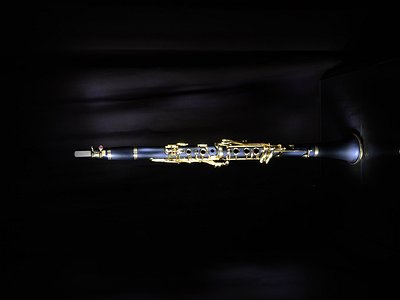Name: Louise Campbell
Nationality: Canadian
Occupation: Composer, performer, improviser, clarinetist
Recent release: Louise Campbell's debut album as a solo artist, Sources, is out via Redshift.
Tool of Creation: Clarinet
Type of Tool: Reed instrument
Country of origin: Germany
Became available in: Around the turn of the 17th/18th century
If you enjoyed this interview with Louise Campbell about the clarinet and would like to explore her work and various projects in more depth, visit her official website. She is also on Instagram, Facebook, and Soundcloud.
What was your first encounter with the clarinet? What was it about it that drew you in?
I started playing on my father’s clarinet which he played as a teenager. When it came time for me to choose an instrument for junior high band, my dad took out the clarinet, showed me how to put it together and played the beginning of Gershwin’s Rhapsody in Blue.
Our dog at the time tiptoed into the room while he was playing, looking very uncertain of what was going on. She stuck her nose up the bell, sneezed and took off running. She kept her distance when I practiced for a year or two after that. I took it as quite a compliment when she started to keep me company while I practiced.
Right from this first experience, playing clarinet just felt good. It was a good match for me, and still is.
Just like any other instrument, the clarinet has a rich history. What are some of the key points from this history for you personally?
The main turning points in the history of the clarinet have to do with an evolution in engineering that resulted in a change in instrument design. One of these turning points happened around 1800 when there was a major change in key design.
In general, clarinets prior to 1800 were built using levers for keys, with each key mounted on a raised block on the instrument so the pad of the key lay flush with the tone hole. There was a limit to how many keys could be mounted on the instrument, because each additional key weakened the wood. As a result, the instrument used a lot of cross-fingerings, which gave a characteristic sound to each note.
Around 1800, keys started to be mounted using a rod system that weakened the wood of the instrument far less, allowing many keys to be added and eliminating the need for cross-fingerings. This resulted in a fully-chromatic scale with an even sound across the entire scale of the instrument. For me, it is fascinating to hear how musicians used the characteristics of the pre- and post-1800 clarinets to their advantage. The Stamitz concertos in particular are completely different pieces when we look at them through the lens of the historical clarinet they were written for.
It’s a good lesson to use the tool as it is for its qualities, rather than assuming something is ‘lesser than’ because it may not do certain things well.
What, to you, are some of the most interesting clarinet recordings and -performances by other artists in terms of your personal development?
With regards to most interesting recordings, I’m going to open this question up to the most interesting single reed recordings.
Sometimes I find that the use of electronics in music can feel like listening to a machine, rather than to a person. Saxophonist Jason Sharp’s album Stand Above The Stream showed me one way that the use of electronics with a wind instrument can be humanized.
Jason literally amplifies the human aspect of music by mic-ing his own heartbeat and using it as the beat in his pieces. The album launch was one of the most exciting shows I’ve been to. Jason must have been pumped up to be on stage, because his heartbeat was a fair bit higher than resting heart rate, and the music was really driving forward.
I’m sure everyone’s heartbeat started to race to keep up with his! I know mine did.
[Read our Jason Sharp interview]
When talking about electronic devices, we often think about their “features”. But the clarinet is a complex device, too. What are some of its stand-out features from your point of view? How would you describe its sonic potential?
The clarinet is a musical chameleon. It can blend with many, many other sounds and instruments, has a huge range of pitch and dynamics, and is used in a wide range of genres and traditions.
This diversity of genres is one the characteristics of the instrument that keeps me coming back. There is always more music to learn and play.
Instrument design is an ongoing process. Are you interested in recent developments for the clarinet in this respect?
The clarinet we play today is essentially a Romantic instrument, with relatively few developments since the turn of the twentieth century.
I’m fairly pragmatic when it comes to my instrument. I look for standard gear that responds well. This way I can get quickly to making music instead of fussing over gear, and if I ever need to fix my clarinet when I’m on the road, the local music shop will have what I’m looking for.
Tell me about the process of learning to play the instrument and your own explorations with it.
I learned to play the clarinet through private lessons, band and orchestra. I already played the piano, sang and tinkered with a few other instruments, so clarinet was simply another way of playing music for me.
My clarinet teachers were all Classical musicians. Lessons followed the standard conservatory approach of long tones, scales, learning repertoire and playing festivals. I had some pretty adventurous teachers, so I played a lot of contemporary music and was encouraged to compose and explore many avenues for making music.
What are specific challenges in terms of playing the clarinet?
Finding time to practice is always a challenge, although this isn’t specific to the clarinet.
More specifically, I’m partial to playing on cane reeds because I prefer the feel and response of cane to plastic. Cane reeds take time to break in and change with the weather, so it does take a certain amount of effort to make sure my reeds are responding well.
Louise Campbell Interview Image by Vivian Doan
What interests you about the clarinet in terms of it contributing to your creative ideals? How do you see the relationship between your instrument and the music you make?
The main thing that interests me about the clarinet is that I’ve got a 30+ year relationship with it! It’s my main axe.
Perhaps even more than my relationship with the clarinet, my relationship with music has changed over the years. I’ve always been very curious as a musician. The clarinet is great for this because I can explore many types of musics, including Classical, bebop jazz, klezmer, and most recently choros, not to mention the wide variety of musicians and ensembles I play with.
All of this feeds into the music I make.
Some see instruments merely as tools towards creativity, others feel they go hand in hand. What's your take on that?
It’s very clear to me that my creativity is shaped by my primary instrument, the clarinet. While my musical practice includes a variety of tools and strategies for exploring music and sound, I have a lifetime of practice on the instrument.
There are some characteristics of the clarinet that I love, like it’s lyricism and ability to sustain and shape the ‘inside’ of a note. These elements show up in my music all the time, even when I’m composing for instruments like guitar, where the sound envelope is more about the attack of the note than the sustain.
On the flip side, one of the weaknesses of the clarinet to my mind is that it is mainly a melody instrument. I started extending my instrument with electronics because I’m fascinated with harmony - with a device as simple as a loop pedal, I can build whole soundworlds that go far beyond one single melody.
So the clarinet both forms and shapes my creativity, and pushes me to seek out more skills and tools to make the music I want to hear. My album Sources comes out of both the deep relationship I have with the clarinet and the ways in which I am looking to make music that expands beyond its traditional realms.
How would you describe your personal style of playing the clarinet?
I like lyricism, and tend to go for melody and evocative textures rather than virtuosity. Much of my own music is very slow, even if the individual notes are fast, as in Playing Guitar Gear.
In both my playing and composition, I really enjoy finding ways to slow down our sense of time, and give people a moment to relax and breathe.
What does playing your instrument feel like, what do you enjoy about it, what are your own physical limits and strengths?
Playing the clarinet is a full body experience that connects breath, body and sound. It’s tricky to explain, but it’s like the sound vibrates through your body, in the bones and empty air spaces. This physical sensation is probably part of why I tend to be a lyrical player - slower music gives me time to enjoy this sensation and take the time to use it to shape the sound.
It also may be why I don’t go for a lot of virtuosity - since I don’t tend to make fast music, I need to work at it more when I need to run around the clarinet for other people’s music.
Could you describe working with the clarinet on the basis of one of your pieces, live performances or albums that's particularly dear to you, please?
"Songbird" is a very special one.
This piece came on the tail of me breaking my arm. Once it healed up and the physio gave me the okay to start playing again, I was shocked at how little I could play. My hand was so weak I could only play 5 minutes a day - and those 5 minutes were hard. I needed something to let me be creative and make practicing fun while giving my hand the time to build up strength.
That’s when I started playing half-clarinet (i.e. no need for the left hand at all) and using loop pedals. Looping was perfect, I could record a loop, sit there and listen to it, overdub something, listen to it some more, overdub again … essentially a way to make music that was not taxing for my hand, and really fun.
"Songbird" came out of this time when I was learning something new and having a great time playing music after 4-5 months of not playing at all.
How, would you say, does the clarinet interact with other instruments from ensembles/groups you're part of?
Clarinet is like glue. It holds the ensemble together by blending with and supporting the other instruments.
Are there other clarinet players whose work with their instrument you find inspiring? What do you appreciate about their take on it?
The first time I heard Lori Freedman play, I remember thinking, ‘How come I didn’t know about her before?’ The sounds she got out of the instrument were wild, and completely opened up my mind about what the clarinet is capable of.
[For the thoughts of one of Lori Freedman's frequent collaborators, read our Scott Thomson interview]
James Campbell, my clarinet professor when I did my masters at Indiana University, also was absolutely formative in my development as a clarinet player and musician. One of the most striking performances I’ve heard of Jim’s was in Montreal when he played Messaien’s Quartet for the End of Time with the Gryphon Trio.
Jim walked the audience through the piece before they played, giving everyone the historical, musical and emotional context with which to understand the work. This is no small feat for a work composed in a World War II prisoner of war camp. This introduction set the stage for us to engage with the beauty and devastation of this incredible work.
His musicality and ability to communicate with an audience is always inspiring, as is his grounded approach to life as a musician and person.





